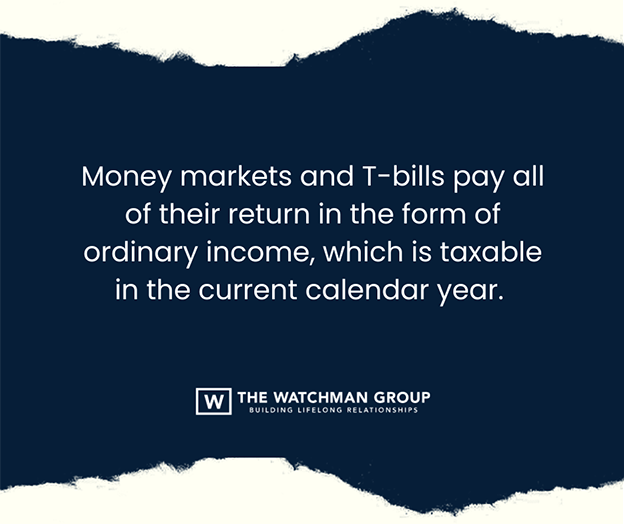Tax Efficiency and Investment Gains:
Unraveling the Stocks vs. Bonds Debate
Key takeaways:
- Equity Risk Premium: The equity risk premium, ranging from 3.5% to 5.5%, represents the extra return expected from stocks due to their risk compared to safer investments. When combined with the 5% return from Treasury Bills, it suggests stocks may provide around 8% to 11% in total returns.
- After-Tax Returns: Considering taxes is crucial; bonds are taxed immediately as interest is earned, whereas stocks are taxed upon sale, often at lower capital gain rates. This tax advantage can significantly impact after-tax returns.
- Comparing Scenarios: An example demonstrates that even if stocks and Treasury bills yield the same rate of return, stocks tend to provide more substantial gains after taxes, especially over longer periods, emphasizing the importance of tax considerations in investment choices.
In today’s market, the allure of attractive yields has piqued the interest of investors seeking to optimize their financial gains. Amidst options like Schwab’s money market funds and Treasury bills, boasting returns surpassing 5%, the possibilities are enticing. However, this resurgence in interest prompts the perennial inquiry: Should one allocate their investments to stocks or bonds when bonds promise a secure 5% return?
Yield Considerations and the Stocks vs. Bonds Debate
Once again, the enduring debate over stocks versus bonds has resurfaced, fueled by the superior returns currently available in the bond market. The question arises: “Why venture into the riskier realm of stocks when bonds offer a safe 5% return?” It’s a valid query, and it leads us to delve into two crucial concepts: The Equity Risk Premium and After Tax Returns. Let’s delve into each of these below.
- The Equity Risk Premium: Calculating Expected Returns
In this comparison, an essential notion is the ‘equity risk premium.’ This denotes the additional return expected from stocks due to their inherent risk compared to safer investments such as Treasury Bills or Bonds.Experts suggest this premium falls within the range of 3.5% to 5.5%. When combined with the 5% return achievable from Treasury Bills, it implies that stocks may yield approximately 8% to 11% in total returns. This aligns with the historical performance of stocks over extended periods. - After-Tax Returns: The Importance of Considering Uncle Sam
The second, and perhaps more critical, consideration is the impact of taxes. When discussing taxable accounts, the case for bonds weakens considerably. Money market funds and T-bills distribute their returns as ordinary income, subject to taxation in the current calendar year.

A high-income earner may witness a 5% yield dwindling to 3% after tax deductions. In contrast, stocks primarily generate returns through capital appreciation, which incurs lower capital gains taxes and is only triggered upon selling the asset. Thus, stocks offer a tax advantage in terms of returns.
Quantifying the Impact: Comparing Investment Scenarios
Let’s quantify an example.
If a high-income individual earns 5% annually from Treasury bills over five years, their initial $100 investment grows to approximately $115.70 after taxes, resulting in an annualized after-tax return of 3%. In contrast, if the same individual invests in a mix of stocks for five years, returning an average of 8% annually, and subsequently sells, their initial $100 investment becomes about $135.76 after taxes. The stock portfolio delivers an annualized after-tax return of 6.3%. This represents a significant 3%+ annual difference, with compounding effects magnifying the gap over longer timeframes.
Note: An investor’s tax bracket significantly influences this analysis, with the above example assuming the highest tax bracket. The argument weakens for individuals in lower marginal tax brackets.
- Tax Advantage of Stocks: Making Sense of Higher Returns
When assessing investment options, accounting for taxes emerges as a pivotal component. It’s not solely about what you earn but what you retain after taxation. This aspect adds intrigue to the stocks versus yield-oriented investments, such as Treasury bills, conundrum. - The Tax Breakdown: Stocks vs. Other Investments
One reason stocks yield more post-tax returns is their tax treatment. The majority of gains from stocks arise from capital appreciation, which incurs taxes only upon sale—an option left to the investor’s discretion. Moreover, these tax rates are typically lower than those applied to ordinary income, like the interest from Treasury bills or other yield-oriented investments. - The Taxing Details of Other Investments
Conversely, earnings from current yield investments like Treasury bills or bonds are classified as ordinary income, subject to immediate taxation in the year they accrue, even if the funds remain unwithdrawn. This tax bite erodes returns.
Therefore, when evaluating investment returns, it’s essential to consider the associated tax implications. Stocks and equity assets like Real Estate present advantages due to the control they afford over tax timing and the potential for substantial capital appreciation. This control, coupled with the prospect of higher returns, can significantly enhance post-tax earnings.
Even if stocks and T-bills were to yield the same rate of return, investors who opt for stocks are likely to emerge with more substantial gains after accounting for taxes. While Treasury bills serve as an excellent choice for short-term needs, over extended periods, stocks continue to be the superior avenue for wealth creation and growth.


